 ABOUT AUTHOR
ABOUT AUTHOR
Vinay Kumar Singh.
Chief Research Officer
Parammount Cosmetics India Limited,
Bangalor, Karnataka
vinay@parammount.com
Many articles have been written on Colour Cosmetics. I too have written a few articles on Colour Cosmetics. A M. Tech. student of mine from ICT (formally UDCT of Mumbai University) called me to ask me to send him a write up on Colour Science and its impact on colour cosmetics; which prompted me to write this article which is an amalgam of Basics of colours, science behind colour and its usage in Cosmetics.
[adsense:336x280:8701650588]
Let me begin with basic colour physics. Let us first understand what is colour?
The sensation of color is evoked by the physical stimulation of light-sensitive elements in the human retina.
The stimulation consists of electromagnetic radiation in the visible spectrum comprising wavelengths between 380 and 780 nm.

To see a colour we need a) a Light source b) an object and c) an observer An object has to be illuminated. Light source is an illuminant. It could be a) Day light b) Tungsten light c) Flourescent light. Object selectively absorbs certain wavelength and reflects other. The luminocity of an object is related to sensitivity of human eye.
Visual system need colour to find people’s skin, to tell which food is edible, to check whether a person’s appearance looks normal/healthy or for artistic appreciation of an object. Eye has specific light-sensitive elements, known as cones, which can be separated into three classes, each class being sensitive to a different spectral distribution of radiation.
Retina contains three types of receptors (red, blue and green). Humans are tri chromats where as mammals are dichromats. Many different spectral distributions can produce the same perceived color. Physically, different spectral distributions producing same color sensation is called Metamerism.
Metamerism is fundamental to the science of color measurement.
Color is light, and light is composed of many colors— those we see are the colors of the visual spectrum: red, orange, yellow, green, blue, and violet. Objects absorb certain wavelengths and reflect others back to the viewer. We perceive these wavelengths as color.
Chroma, intensity, saturation and luminance/value are inter-related terms and have to do with the description of a color. Chroma =Purity, Saturation=degree of purity, Intensity =Brightness or dullness, Value /Luminance = amount of light reflected. COLOR is a phenomenon of perception not an objective component or characteristic of a substance.
Color is an aspect of vision; it is a psychophysical response consisting of a) the physical reaction of the eye, b) automatic interpretive response of the brain to wavelength characteristics of light.
Different people can also see color differently. There are two types of colour synthesis A) additive colour synthesis, B)subtractive colour synthesis. There are two ways of perceiving colour by human eye by reflected light by an opaque object or transmitted light through a medium.
In both ways entire spectrum of light minus wavelength of particular light is perceived by eye and colour impression is made in the brain. This is called subtractive colour system.
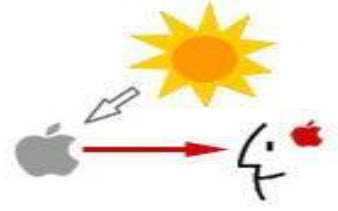
Subtractive color mixing means that one begins with white and ends with black; as one adds color, the result gets darker and tends to black.
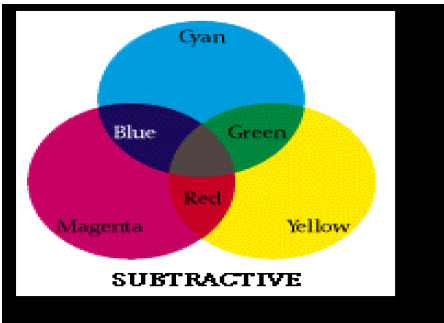
Basic colours are cyan , Magenta and Yellow.
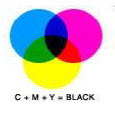
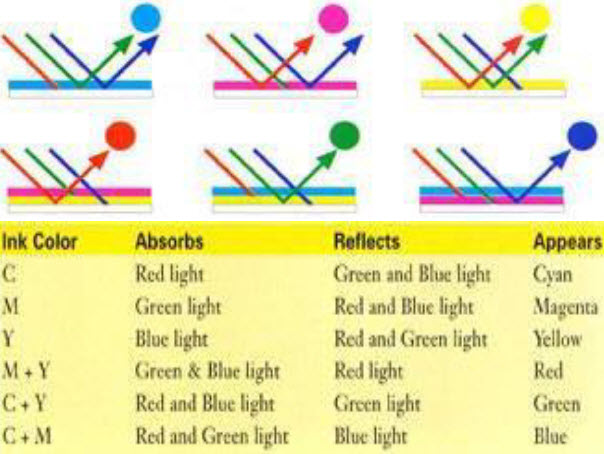
Additive Colour system: Electronic color displayed on television and computer is single wavelength colours are additive colours. In this case when these individual colours are added it creates white light.
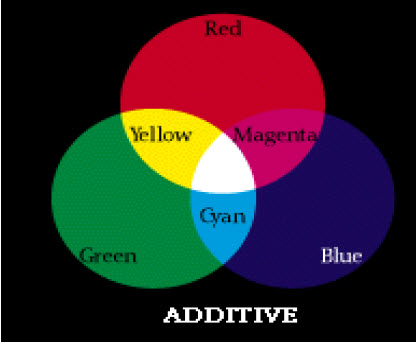
In this case primary colours are red, blue and green.
Subtractive colour system or CMYK is actually that we see in nature. The combinations possible are limited. Painters, printers, use a white base and go on mixing these opaque colours and match required shade. In electronic colour possibilities are innumerable in fact we can produce 1.6 crore distinct colours. What we see on a television/computer screen are metameric colours and all these can not be naturally printed.
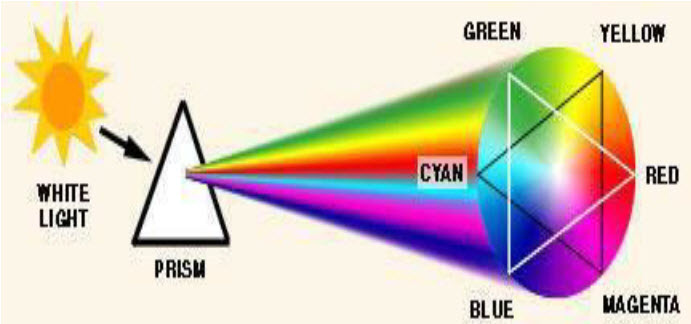
NOW YOU CAN ALSO PUBLISH YOUR ARTICLE ONLINE.
SUBMIT YOUR ARTICLE/PROJECT AT editor-in-chief@pharmatutor.org
Subscribe to Pharmatutor Alerts by Email
FIND OUT MORE ARTICLES AT OUR DATABASE
Colour wheel : visual representation of colors arranged according to their chromatic relationship
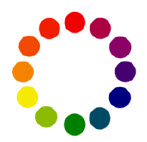
Primary, secondary and tertiary colours

Complementary Colors: Those colors are located opposite t o each other

Analogous Colors: Those colors located close together on a color wheel
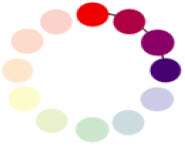
Absorption and reflection of different wavelengths of light generates colour. These wavelengths can be measured by spectrophotometer or colorimeter
Principle of spectrophotometer: It measures light energy absorbed or reflected by a material. Multiple sensor receives transmitted or reflected light by the help of microprocessor. If the output is expressed as numerical data linked to absorbance/reflectance of colours they are called colorimeters. The data from colorimeter can be evaluated where in human eye can not differentiate.
Eye response to light stimulus: Light, no matter how complex its composition of wavelengths, is reduced to three color components by the eye.
For each location in the visual field, the three types of cones yield three signals based on the extent to which each is stimulated. These values are sometimes called tristimulus values.
Color expression: Phenomenon of trichromacy - Any color stimulus can be matched by a mixture of three primary stimuli, so long as none of the three can be matched by a mixture of the other two.
Color matching can be expressed as: C (tristimulus value) =RR +GG+BB
Equal stimulus proportions of all three primaries create white:
1 Red+ 1 Blue + 1 Green = 1White
Equal stimulus proportions of two primary colors create a secondary color.
1 Red+1 Blue=Magenta
1 Blue+1 Green=Cyan
1 Green+1 Red=Yellow

Spectral sensitivity of Human eye: There are three types of cones on the basis of wavelength they absorb. Short, Medium & Long.

Sensitivity of eyes: Three white curves indicate responses of three types of cones for color stimulus red (564) blue (437)and green (533). Black curve indicate sensitivity of sensory rods at night.
colour communication system: Lab is based on continuum of color wheel and expression of lightness and darkness on vertical plane. There are several other adaptations of Lab colour matching system like Munsel colour wheel. Other example is Pantone color chart.
Infinite number of colours surround us in our daily life. We Take colour pretty much granted but influence of colours is enormous. It helps to understand taste in food, influence our purchase decisions. It has lasting impression. It distinguishes beauty, helps in Likes & Dislikes. Integrity of colour within environment features unique code and conduct in animals & insects. Species have developed camouflaging colours to improve survival. Some species change colour to different situation and different season. Primitive tribes used Colour makeup has been used to enhance their predator instincts, frighten tribal enemies, attracting and capturing, for match and mate. Cosmetic Science is a science which deals in health and good appearance of Skin and its appendages. Impressions of Beauty are intrinsically linked to colour appearance as Healthy skin/fair skin/Flawless skin, Jet black/Blonde hair, Bold eyes, Blushing cheeks, Luscious lips & elegant nails.
Emotions and colours are strongly linked - Colour must appeal to emotional makeup of customer at the specific moment of purchasing. Predicting colour trends are both art and science. Societal indicators are used for upcoming colour trends. Fashion shows in Europe and USA consist of fabrics, prints, textures, garment design, accessories, hair & nail makeup etc. Artistic directors put together some of the industry’s hottest colour and makeup collection. Colorants has long history. Documented in Egyptian Papyri and found in tombs 5000 year BC. are Henna, Kohl, Carmine, saffron, copper & antimony compounds. Use of colours in foods & wines started as early as 1860.
First synthetic organic color was discovered in 1856. Proliferation of use of colors in foods was recognized as threat. Now we should understand Colour nomenclature. US FDA took up monumental task of assessment of safety of nearly 700 coal tar colors and created three categories of safe colors: FDC colors, D&C colors, and Ext D&C colors. Colours are given numbers like FDC blue 1, D&C red 3 or Ext D&C green 4. In European classification EC nomenclature Number given like E 102. In many countries colours are listed as Colour index numbers. CI numbers are allocated by Society of dyers and colourists UK. Scheme covers colours used in food, personal care products, cosmetics, house hold products and fabric dyeing. Example: Tartarazine CI no 19140 Erythrosine CI No.45430.
NOW YOU CAN ALSO PUBLISH YOUR ARTICLE ONLINE.
SUBMIT YOUR ARTICLE/PROJECT AT editor-in-chief@pharmatutor.org
Subscribe to Pharmatutor Alerts by Email
FIND OUT MORE ARTICLES AT OUR DATABASE
Classification of colors: It can be classified as below.
Synthetic colours – Largest group synthesised from coal or petroleum. It was formally known as coal tar colours. Many of the synthetic organic colours are azo dyes, but many other organic group based dyes like quinoline, xanthene, indigoid colourants are also used extensively. Original azo colourants were developed from coal tar that is reason, they were termed coal tar colourants. The present day colourants are not made from coal tar. Natural Colours: Derived from plant, animal and mineral origin.
Plant origin : henna, Indigo, Annatto, caramel, canthaxanthin, Turmeric, Chlorophyl, saffron, Beta carotene, Animal/insect origin colours – Carmine Inorganic colours- Iron oxides, Ultramarine blue, Titanium dioxide, Zinc oxide, Chromium oxide, manganese phosphate, bismuth oxy chloride, Mica, ferric ferro cyanide, Copper, bronze & aluminium powders.
Following Colourants from Natural source are used.
Annatto extract- Extract derived from annatto seeds. The oil is rich in carotinoid Bixin. Colour varies from butter yellow to peach. Used manly for colouring foods B carotine- Derived from Carrots, Alfalfa, and certain cereals. Bright orange red colour used as food colorant. Canthaxanthin- Brownish violet colour derived from certain variety of mushrooms Caramel – Derived from careful heating of sugar molasses dextrose etc. Brown colour used in pastries Carmine – Cochineal extract – Extract of bodies of female insect coccus cacti. Strong violet color is mainly consisting of Carminic acid. Extensively used various cosmetics Guanine – pearl pigment from fish scales Paprika and paprika oleo resin- Principle derived from red chillies. Iron oxides – Natural iron oxides are available but not suitable for cosmetic applications. Synthetic iron oxides are commonly used Saffron – Dried stigma of plant crocus sativus Talc –CI No.77019 – large production variety of applications Titanium Dioxide Turmeric and turmeric oleo resin Ultramarines Zinc oxide.
Nacreous Pigments: Pigments which achieve lustrous brilliance or iridescent color effects by interference in thin optical films to simulate natural pearls are called nacreous pigments Types: Natural pearl essence, Bismuth oxy chloride, Metal oxide-Mica pigment, and Metal oxide –Borosilicate.
Indian Colour Cosmetics Laws :
All colours used in cosmetics must follow specific requirement of IS 4707
part 1. Colourants are classified under the C I number and colourant name. Area of usage – Specific colours are approved for specific areas.
1) Generally approved for all areas
2) Eye area use
3)Area of use where in colour cosmetic will come in contact with mucous membrane
4) Externally applied cosmetics where in products will come in contact with skin briefly Each colour will have certain restriction on limit of usage.
Colour cosmetics- global scenario: Colour cosmetics global market in 2014 was 57.4 billion $,which is expected to reach 77.7 billion $ by 2020. A dominant category and continuing demand and attention to satisfy the exacting needs of modern women. Market demands new technologies and new innovations. Today`s colour cosmetics are fuelled by formulas that offer sublime effects. A plethora of colours finishes textures cater to trend savvy women Nature of present day colour cosmetics: It is not just fashion accessories but also require to have following characteristics a) convenient, b) provide benefit to skin, c) long lasting, d) non irritating, e) appeal to smaller & new customers. Desired property of Makeup: To creating an impression of glamour, glow, healthy, and natural look. It delivers bold and dynamic appearance of lip and nail, soft and smoldering look of eyes. It must also offer ease of application, uniformity of texture and feel and durability.
Following are Colour cosmetic product propositions (Trend) : Multi functional products : Long lasting, perfect wear, two in one, wet & dry, Colour release, Adjustable colour, oil free/oil control, low lustre/matt, light diffusing Colour with health benefits : Sun protecting, paba free, moisturising, perfume free, hypoallergenic, non comedogenic, free from ingredients of animal source, perfume free. Colour plus convenience : Water proof, smudge proof, powder to liquid, slimline, refill pack, trial size. Colour plus visual effects: mottled, swirled, two in one, three in one, Confetti, 3 D effect, Liquid crystal. Back to nature - Eco friendly, natural/herbal ingredients, non synthetic, Environment friendly.
Now let us understand what colour does to us. Colors play a very important role in our lives, whether we realize it or not. They have the ability to affect our emotions and moods in a way that few other things can. Your own feelings about colors can of course also be very personal. Color meanings may have something to do with your past, your experiences or your culture. For instance, while the color white is often used in many Western countries to represent purity and innocence, it is seen as a symbol of mourning in many Eastern European countries.
Color can say “stop,” it can say “go,” it can say “slow down.” It can be bright or dull, cold or romantic, eye-catching or mind-numbing—and it has many names and forms. According to Joy Turner Luke, artist and art lecturer, “Even though color seems intuitive and simple, it is not. It involves some of the most complicated things on Earth—light and the human eye and brain. That’s why every year Colour of Year is selected as colour play very important role in our life.
Pantone’s Colour of the Year for 2015 was Marsala.
Pantone’s Colour of the Year for 2016 is Rose quartz (pale pink) & Serenity (baby blue), first time in the history, a twin shade.
Pantone’s Colour of the Year for 2017 has been decided to be Greenery- A refreshing and revitalizing shade, Greenery is symbolic of new beginnings.
Demand for colour cosmetics is expected to remain high, with the area having a projected constant 2015 price value CAGR of 16% and sales set to reach INR114 billion by 2020. Much of this growth is expected to be driven by the growing aspirations of Indian women. According to Euromonitor International consumer data, the female employment rate in India in 2015 was close to 29% and this is expected to increase, as more women join the work force, which is expected to result in increased image awareness, higher financial freedom for women and greater expenditure on various beauty and personal care products that help to enhance looks. Colour cosmetic products provide an easy and effective means of achieving better looks and demand for these products will thus remain high. Colour cosmetic products such as lipsticks, lip gloss, nail polish, eye liners, Kajal and mascara are growing in popularity.
“Working successfully with color requires both emotion and knowledge,” It is not an easy task to work on colour cosmetics as there are several elements to understand before getting into the aspect of colour cosmetics. First, there is the element of pigment; second, the three dimensions of a color; third, color harmonies; and fourth, color reflectiveness. Understanding all these elements is important, as they come into play in color cosmetics trends.
NOW YOU CAN ALSO PUBLISH YOUR ARTICLE ONLINE.
SUBMIT YOUR ARTICLE/PROJECT AT editor-in-chief@pharmatutor.org
Subscribe to Pharmatutor Alerts by Email
FIND OUT MORE ARTICLES AT OUR DATABASE










